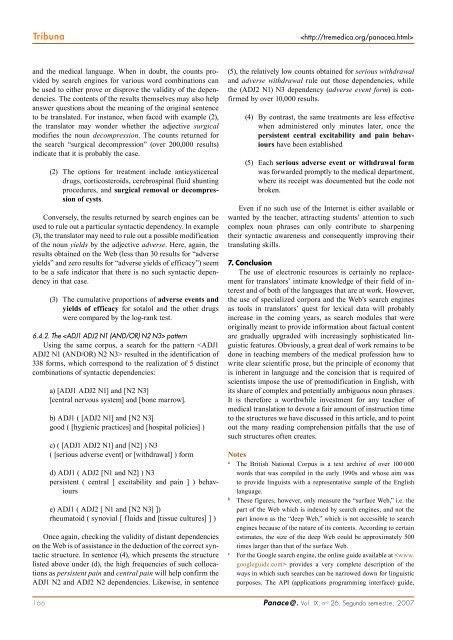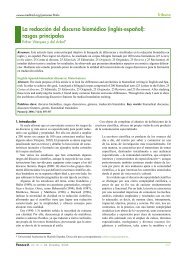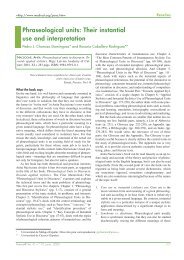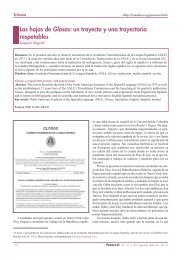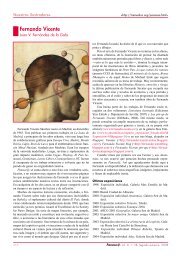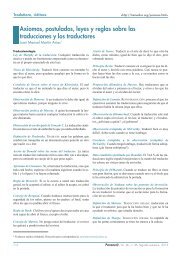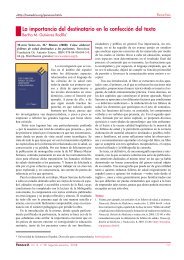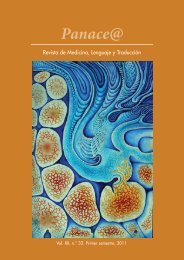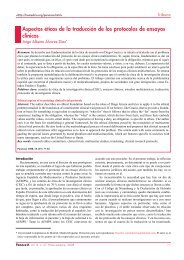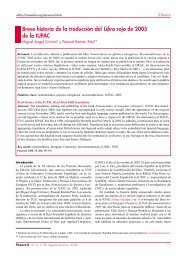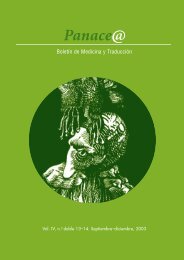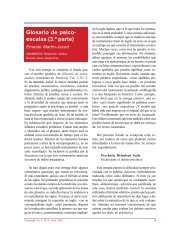Panace@ 26. Diciembre del 2007 - Tremédica
Panace@ 26. Diciembre del 2007 - Tremédica
Panace@ 26. Diciembre del 2007 - Tremédica
Create successful ePaper yourself
Turn your PDF publications into a flip-book with our unique Google optimized e-Paper software.
Tribuna<br />
<br />
and the medical language. When in doubt, the counts provided<br />
by search engines for various word combinations can<br />
be used to either prove or disprove the validity of the dependencies.<br />
The contents of the results themselves may also help<br />
answer questions about the meaning of the original sentence<br />
to be translated. For instance, when faced with example (2),<br />
the translator may wonder whether the adjective surgical<br />
modifies the noun decompression. The counts returned for<br />
the search “surgical decompression” (over 200,000 results)<br />
indicate that it is probably the case.<br />
(2) The options for treatment include anticysticercal<br />
drugs, corticosteroids, cerebrospinal fluid shunting<br />
procedures, and surgical removal or decompression<br />
of cysts.<br />
Conversely, the results returned by search engines can be<br />
used to rule out a particular syntactic dependency. In example<br />
(3), the translator may need to rule out a possible modification<br />
of the noun yields by the adjective adverse. Here, again, the<br />
results obtained on the Web (less than 30 results for “adverse<br />
yields” and zero results for “adverse yields of efficacy”) seem<br />
to be a safe indicator that there is no such syntactic dependency<br />
in that case.<br />
(3) The cumulative proportions of adverse events and<br />
yields of efficacy for sotalol and the other drugs<br />
were compared by the log-rank test.<br />
6.4.2. The pattern<br />
Using the same corpus, a search for the pattern resulted in the identification of<br />
338 forms, which correspond to the realization of 5 distinct<br />
combinations of syntactic dependencies:<br />
a) [ADJ1 ADJ2 N1] and [N2 N3]<br />
[central nervous system] and [bone marrow].<br />
b) ADJ1 ( [ADJ2 N1] and [N2 N3]<br />
good ( [hygienic practices] and [hospital policies] )<br />
c) ( [ADJ1 ADJ2 N1] and [N2] ) N3<br />
( [serious adverse event] or [withdrawal] ) form<br />
d) ADJ1 ( ADJ2 [N1 and N2] ) N3<br />
persistent ( central [ excitability and pain ] ) behaviours<br />
e) ADJ1 ( ADJ2 [ N1 and [N2 N3] ])<br />
rheumatoid ( synovial [ fluids and [tissue cultures] ] )<br />
Once again, checking the validity of distant dependencies<br />
on the Web is of assistance in the deduction of the correct syntactic<br />
structure. In sentence (4), which presents the structure<br />
listed above under (d), the high frequencies of such collocations<br />
as persistent pain and central pain will help confirm the<br />
ADJ1 N2 and ADJ2 N2 dependencies. Likewise, in sentence<br />
(5), the relatively low counts obtained for serious withdrawal<br />
and adverse withdrawal rule out those dependencies, while<br />
the (ADJ2 N1) N3 dependency (adverse event form) is confirmed<br />
by over 10,000 results.<br />
(4) By contrast, the same treatments are less effective<br />
when administered only minutes later, once the<br />
persistent central excitability and pain behaviours<br />
have been established<br />
(5) Each serious adverse event or withdrawal form<br />
was forwarded promptly to the medical department,<br />
where its receipt was documented but the code not<br />
broken.<br />
Even if no such use of the Internet is either available or<br />
wanted by the teacher, attracting students’ attention to such<br />
complex noun phrases can only contribute to sharpening<br />
their syntactic awareness and consequently improving their<br />
translating skills.<br />
7. Conclusion<br />
The use of electronic resources is certainly no replacement<br />
for translators’ intimate knowledge of their field of interest<br />
and of both of the languages that are at work. However,<br />
the use of specialized corpora and the Web’s search engines<br />
as tools in translators’ quest for lexical data will probably<br />
increase in the coming years, as search modules that were<br />
originally meant to provide information about factual content<br />
are gradually upgraded with increasingly sophisticated linguistic<br />
features. Obviously, a great deal of work remains to be<br />
done in teaching members of the medical profession how to<br />
write clear scientific prose, but the principle of economy that<br />
is inherent in language and the concision that is required of<br />
scientists impose the use of premodification in English, with<br />
its share of complex and potentially ambiguous noun phrases.<br />
It is therefore a worthwhile investment for any teacher of<br />
medical translation to devote a fair amount of instruction time<br />
to the structures we have discussed in this article, and to point<br />
out the many reading comprehension pitfalls that the use of<br />
such structures often creates.<br />
Notes<br />
a<br />
The British National Corpus is a text archive of over 100 000<br />
words that was compiled in the early 1990s and whose aim was<br />
to provide linguists with a representative sample of the English<br />
language.<br />
b<br />
These figures, however, only measure the “surface Web,” i.e. the<br />
part of the Web which is indexed by search engines, and not the<br />
part known as the “deep Web,” which is not accessible to search<br />
engines because of the nature of its contents. According to certain<br />
estimates, the size of the deep Web could be approximately 500<br />
times larger than that of the surface Web.<br />
c<br />
For the Google search engine, the online guide available at provides a very complete description of the<br />
ways in which such searches can be narrowed down for linguistic<br />
purposes. The API (applications programming interface) guide,<br />
166 <strong>Panace@</strong>. Vol. IX, n .o <strong>26.</strong> Segundo semestre, <strong>2007</strong>


